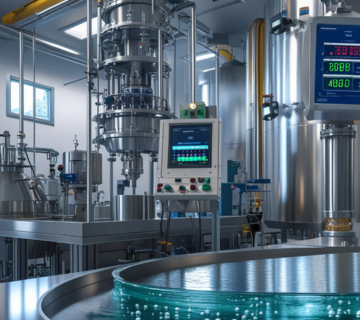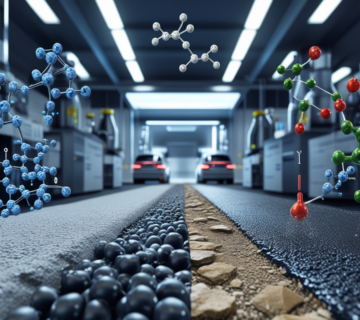Introduction
The conversion of ammonium cyanate (NH₄CNO) to urea (CH₄N₂O) is one of the most significant reactions in organic chemistry, bridging the gap between inorganic compounds and organic synthesis. This reaction was first discovered in 1828 by Friedrich Wöhler, who unintentionally synthesized urea while experimenting with ammonium cyanate. This discovery revolutionized chemistry, disproving the long-standing vitalism theory, which suggested that organic compounds could only be derived from living organisms.
Urea synthesis is widely used today in various industries, including:
✔ Agriculture: As a key nitrogen fertilizer, helping improve soil fertility and crop yields.
✔ Pharmaceuticals: Used in medical formulations, dermatology products, and drug synthesis.
✔ Chemical Manufacturing: Plays a vital role in the production of polymers, resins, and adhesives.
Beyond its industrial applications, the reaction itself remains a cornerstone of organic chemistry, as it represents an isomerization process where ammonium cyanate simply rearranges into a more stable molecular structure—urea. Understanding the mechanism, properties, and industrial significance of this reaction allows chemists to develop more efficient, scalable, and sustainable processes for chemical production.
For an in-depth exploration of urea chemistry, visit Riyoniz Urea Chemistry.
Historical Background
The conversion of ammonium cyanate to urea is one of the most historically significant reactions in organic chemistry, marking a pivotal moment in the understanding of chemical synthesis. This transformation was first discovered in 1828 by Friedrich Wöhler, a German chemist, and it played a fundamental role in disproving the theory of vitalism—a dominant belief at the time that organic compounds could only be produced by living organisms.
1. The Discovery by Friedrich Wöhler (1828)
🔬 In an attempt to synthesize ammonium cyanate (NH₄CNO), Wöhler observed that, under heating, it unexpectedly rearranged into urea (CH₄N₂O).
🔬 This was the first recorded case of an organic compound (urea) being formed from an inorganic precursor (ammonium cyanate).
🔬 The reaction was groundbreaking because it showed that biological molecules could be synthesized outside living organisms.
Friedrich Wöhler famously wrote to his mentor:
“I must tell you that I can prepare urea without needing a kidney, either of a man or a dog.”
2. The Impact on Organic Chemistry
Before this discovery, vitalism was widely accepted, suggesting that a “vital force” unique to living organisms was necessary to create organic molecules. However, Wöhler’s experiment proved that organic compounds could be synthesized through chemical processes alone, leading to:
✅ The birth of modern organic chemistry – Scientists began to recognize that organic molecules follow the same chemical laws as inorganic ones.
✅ Rapid advancements in chemical synthesis – This discovery paved the way for synthetic pharmaceuticals, industrial chemicals, and polymer science.
✅ A new understanding of isomerization – The reaction showed that molecules could rearrange their atomic structure without changing their chemical formula.
3. Evolution of Urea Synthesis in Industry
Following Wöhler’s discovery, researchers sought ways to commercialize urea production, leading to:
🛠 Mid-19th Century: Early attempts to manufacture urea for agricultural and medical applications.
🏭 20th Century: Large-scale industrial production of urea through the Haber-Bosch process.
🌱 Present Day: Urea is the world’s most widely used nitrogen fertilizer, essential for modern agriculture.
The transformation of ammonium cyanate to urea remains a fundamental reaction in organic chemistry, influencing research in biochemistry, pharmaceuticals, and chemical engineering.
For more on the evolution of urea chemistry, visit Riyoniz Urea Chemistry.
Understanding the Ammonium Cyanate to Urea Reaction
The conversion of ammonium cyanate (NH₄CNO) to urea (CH₄N₂O) is a classic example of isomerization, where a compound rearranges its atomic structure without altering its molecular formula. This reaction is fundamental in organic chemistry and serves as an excellent case study for molecular rearrangement in chemical reactions.
1. The Chemical Equation
The transformation follows this simple equation:
NH4CNO→CH4N2ONH₄CNO → CH₄N₂O
This reaction occurs spontaneously when ammonium cyanate is heated, leading to a structural reorganization that results in urea formation.
✅ Key Reaction Characteristics:
- The process is an intramolecular rearrangement rather than a traditional chemical reaction.
- No additional reactants or catalysts are needed—just the application of heat.
- The molecular formula remains the same, but the connectivity of atoms changes.
2. Reaction Mechanism: How Does It Work?
The process occurs in the following steps:
🔹 Step 1: Ammonium cyanate dissociates in solution into NH₄⁺ and CNO⁻ ions.
🔹 Step 2: Under heating, the cyanate ion undergoes rearrangement, altering its bonding structure.
🔹 Step 3: The new structure stabilizes, forming urea (CH₄N₂O) as the final product.
This type of reaction is significant because it illustrates how simple heat-induced transformations can result in drastic structural changes in molecules.
3. Why Does This Reaction Happen?
The transformation occurs because urea is thermodynamically more stable than ammonium cyanate. Urea has:
✅ Stronger hydrogen bonding capabilities, making it more stable in solution.
✅ Lower energy state, meaning that once the rearrangement happens, it is irreversible.
✅ More efficient packing in crystalline form, contributing to stability.
This reaction is a fundamental principle in organic synthesis, biological chemistry, and industrial production, proving that chemical processes can mimic biological transformations.
For an in-depth look at urea synthesis, visit Riyoniz Urea Chemistry.
Key Chemical Properties of Ammonium Cyanate and Urea
Understanding the chemical properties of ammonium cyanate (NH₄CNO) and urea (CH₄N₂O) is essential for analyzing their behavior, stability, and applications in industrial and biochemical processes. Although these two compounds share the same molecular formula, their structural arrangement and chemical properties differ significantly due to the isomerization reaction that converts ammonium cyanate into urea.
1. Ammonium Cyanate (NH₄CNO) – Properties and Behavior
🔹 Molecular Structure: Composed of ammonium (NH₄⁺) and cyanate (CNO⁻) ions, forming an ionic compound.
🔹 Physical State: White, crystalline solid, highly soluble in water.
🔹 Melting Point: ~60°C – decomposes upon heating.
🔹 Solubility: Highly soluble in water and polar solvents, forming ionic species.
🔹 Stability: Thermally unstable; under heat, it rearranges into urea.
🔹 Chemical Behavior:
- Exists in equilibrium between ionic and molecular forms.
- Acts as a weak base, reacting with acids to form salts.
- Under heating, it undergoes spontaneous isomerization to form urea.
✅ Key Takeaway:
Ammonium cyanate is an inorganic salt with weak stability, making it highly susceptible to structural rearrangement when exposed to heat or catalysts.
2. Urea (CH₄N₂O) – Properties and Behavior
🔹 Molecular Structure: Composed of two amine (-NH₂) groups bonded to a carbonyl (C=O) functional group.
🔹 Physical State: White, odorless crystalline solid.
🔹 Melting Point: ~133°C – decomposes at higher temperatures.
🔹 Solubility: Highly soluble in water, ethanol, and ammonia but poorly soluble in non-polar solvents.
🔹 Stability:
- Thermodynamically more stable than ammonium cyanate.
- Does not undergo further rearrangement under standard conditions.
- Resistant to hydrolysis at neutral pH but breaks down under acidic or alkaline conditions.
🔹 Chemical Behavior: - Acts as a neutral molecule, unlike the ionic ammonium cyanate.
- Readily forms hydrogen bonds, making it useful in biochemical systems.
- Used as a nitrogen source in fertilizers and protein metabolism in biological organisms.
✅ Key Takeaway:
Urea is a thermodynamically stable organic molecule with strong hydrogen bonding and high solubility, making it highly valuable in agriculture, medicine, and chemical industries.
3. Comparison of Ammonium Cyanate and Urea
| Property | Ammonium Cyanate (NH₄CNO) | Urea (CH₄N₂O) |
|---|---|---|
| Molecular Structure | Ionic (NH₄⁺ and CNO⁻) | Covalent (C=O and NH₂ groups) |
| Stability | Thermally unstable | Highly stable |
| Solubility | Highly soluble in water | Highly soluble in water and ethanol |
| Chemical Behavior | Weak base, reacts with acids | Neutral molecule, forms hydrogen bonds |
| Melting Point | ~60°C | ~133°C |
| Reactivity | Easily undergoes rearrangement | Resistant to further transformation |
The key difference between these two compounds lies in their structural stability. Ammonium cyanate is unstable and undergoes spontaneous rearrangement, whereas urea is highly stable and widely used in biological and industrial applications.
For a deeper understanding of urea chemistry, visit Riyoniz Urea Chemistry.
Applications of the Urea Synthesis Process
The synthesis of urea (CH₄N₂O) from ammonium cyanate (NH₄CNO) has revolutionized multiple industries by providing a versatile, cost-effective, and efficient source of nitrogen-based products. Beyond its historical importance in organic chemistry, urea remains a vital compound in agriculture, medicine, and manufacturing.
1. Agriculture and Fertilizers
🌱 Nitrogen Source for Crops:
- Urea is the most commonly used nitrogen fertilizer worldwide, supplying plants with essential nitrogen to support growth and yield.
- Its high nitrogen content (~46% by weight) and water solubility make it ideal for both solid and liquid fertilizers.
🚜 Soil Improvement and Sustainability:
- By improving soil fertility, urea contributes to sustainable farming practices.
- Controlled-release urea fertilizers help reduce nitrogen runoff, protecting the environment while maintaining crop productivity.
2. Pharmaceutical and Medical Applications
💊 Urea in Dermatology and Healthcare:
- Urea is widely used in dermatological creams and ointments for its moisturizing and keratolytic properties, helping to treat dry skin, psoriasis, and eczema.
- Medical-grade urea is also used in wound care products and as an active ingredient in certain medications.
🧬 Research and Laboratory Uses:
- Urea is an important reagent in biochemical studies, including protein denaturation and enzyme activity analysis.
- In metabolic studies, urea is used as a reference compound for understanding nitrogen excretion and kidney function.
3. Industrial and Chemical Manufacturing
🔧 Resins and Plastics:
- Urea is a key component in producing urea-formaldehyde resins, which are used in adhesives, particle boards, and laminates.
- These resins provide strength, durability, and moisture resistance in construction materials.
🔬 Chemical Intermediate:
- Urea serves as a precursor in the synthesis of melamine and other specialty chemicals.
- It plays a role in the production of explosives, disinfectants, and stabilizers, demonstrating its versatility in industrial applications.
4. Environmental and Sustainable Technologies
🌍 Carbon Capture and Utilization:
- Modern urea production facilities incorporate carbon dioxide capture technologies, converting CO₂ into urea, thereby reducing greenhouse gas emissions.
- Urea-based fertilizers and chemicals contribute to sustainable agricultural practices and industrial operations.
Significance of This Reaction in Organic Chemistry
The conversion of ammonium cyanate (NH₄CNO) to urea (CH₄N₂O) is one of the most historically significant reactions in the field of organic chemistry, as it marked the beginning of a scientific revolution. Discovered by Friedrich Wöhler in 1828, this reaction directly challenged the then-dominant vitalism theory, which stated that organic compounds could only be derived from living organisms.
1. Disproving Vitalism and Advancing Organic Synthesis
Before Wöhler’s discovery, chemists believed that a special “vital force” found only in living beings was necessary to create organic compounds. The synthesis of urea from the inorganic salt ammonium cyanate proved that organic compounds could be produced in the laboratory under controlled conditions. This realization opened the door to a whole new era of chemical research:
✅ The Rise of Synthetic Organic Chemistry:
- Chemists began exploring ways to produce more complex organic molecules, leading to the development of synthetic dyes, pharmaceuticals, and polymers.
- Over time, the principles established by this reaction contributed to the emergence of industrial-scale organic synthesis, transforming medicine, agriculture, and manufacturing.
✅ Foundational Insights into Isomerization:
- The transformation of ammonium cyanate into urea introduced the concept of isomerization in a way that was clearly observable and replicable.
- It helped scientists understand that molecules with identical molecular formulas could rearrange into entirely new compounds, enriching the study of chemical structures and reaction mechanisms.
2. Broad Applications and Theoretical Contributions
🔬 Strengthening Organic Chemistry as a Discipline:
- The reaction served as a milestone for defining organic chemistry as the study of carbon-based compounds, regardless of their source.
- It inspired generations of chemists to investigate other simple compounds and explore how their rearrangements could yield valuable substances.
📖 Educational Value in Chemical Curricula:
- To this day, the ammonium cyanate-to-urea reaction is taught as a fundamental example of how laboratory chemistry can overturn long-held scientific theories.
- Its simplicity and historical importance make it a perfect case study for introducing students to the basics of organic chemistry, including the relationship between structure and reactivity.
Common Challenges in Understanding This Reaction & How to Overcome Them
❌ Thermal Instability:
- Overheating can lead to undesired side reactions.
✔ Solution: Maintain optimal reaction temperature (60-100°C).
❌ Reaction Yield Efficiency:
- Not all ammonium cyanate converts to urea efficiently.
✔ Solution: Use optimized catalysts to improve conversion rates.
❌ Industrial Process Scale-Up Issues:
- Large-scale urea production requires strict temperature and pressure controls.
✔ Solution: Use automated monitoring systems for better control.
Industrial and Laboratory Methods for Urea Synthesis
The synthesis of urea (CH₄N₂O), originally demonstrated as the conversion of ammonium cyanate (NH₄CNO), has evolved over the years into a variety of efficient industrial and laboratory methods. While the historical reaction remains significant, modern production techniques have focused on scalability, efficiency, and environmental impact, ensuring that urea remains one of the most widely used nitrogen-based compounds in the world.
1. Industrial Production of Urea
Today’s industrial urea production is primarily driven by the Haber-Bosch process and subsequent reactions involving ammonia (NH₃) and carbon dioxide (CO₂):
Process Overview:
- Ammonia Production (Haber-Bosch):
- Nitrogen from the air and hydrogen (typically from natural gas) are combined under high temperatures (400-500°C) and pressures (150-200 atm) to produce ammonia.
- Reaction with Carbon Dioxide:
- Ammonia reacts with CO₂ at high pressure to form ammonium carbamate (NH₂COONH₄).
- Dehydration to Urea:
- Ammonium carbamate is then dehydrated, yielding urea and water.
This process is energy-intensive but highly efficient, capable of producing urea on a massive scale to meet global demands for fertilizers, resins, and chemicals.
Environmental Considerations:
- Advanced facilities incorporate carbon capture and storage (CCS) to reduce emissions.
- Modern catalysts and energy recovery systems help improve efficiency and minimize waste.
2. Laboratory Methods for Urea Synthesis
In laboratory settings, urea is synthesized through simpler reactions suitable for small-scale experiments:
Direct Isomerization of Ammonium Cyanate:
- The original Wöhler synthesis involves heating ammonium cyanate under controlled conditions to produce urea.
- This method is valuable for teaching organic chemistry principles and studying molecular rearrangements.
Biochemical Pathways:
- Although not typically used for industrial production, research labs may study urea formation via urea cycle enzymes to better understand metabolic processes in organisms.
- Synthetic biology approaches sometimes mimic natural pathways to explore alternative methods of nitrogen fixation and urea synthesis.
Small-Scale Synthesis for Testing and Prototyping:
- Researchers may experiment with modified ammonium salts or alternative reactants to produce urea under milder conditions.
- This enables the study of reaction kinetics, thermodynamics, and catalyst efficiency in a controlled environment.
Key Differences Between Industrial and Laboratory Methods
| Aspect | Industrial Methods | Laboratory Methods |
|---|---|---|
| Scale | Large-scale, capable of producing millions of tons annually | Small-scale, limited to experimental quantities |
| Energy Requirements | High (requires large reactors, high temperature/pressure) | Moderate to low (simpler setups) |
| Environmental Impact | Advanced technologies to reduce emissions | Minimal, as reactions occur in controlled settings |
| Purpose | Production of fertilizers, resins, and chemicals | Education, research, and prototyping |
Environmental and Safety Considerations
Ensuring both environmental sustainability and operational safety is critical when synthesizing urea and handling the precursor chemicals, including ammonium cyanate. Although urea production and its derivatives have vast applications in agriculture, industry, and medicine, manufacturers and researchers must carefully manage environmental and safety challenges to maintain compliance, protect the workforce, and reduce ecological impact.
1. Environmental Impact
🌱 Greenhouse Gas Emissions:
- Urea production often involves the use of ammonia, which is produced via the Haber-Bosch process. This process is energy-intensive and emits significant amounts of CO₂, contributing to climate change.
- Modern production facilities are investing in carbon capture and storage (CCS) technologies to trap and store CO₂ before it enters the atmosphere.
🌱 Nitrogen Runoff and Water Pollution:
- Urea-based fertilizers, when overapplied, can lead to nitrogen runoff into waterways, causing eutrophication—a process that depletes oxygen in water bodies and harms aquatic ecosystems.
- Precision agriculture techniques and controlled-release fertilizers can help minimize these effects by ensuring that nitrogen is absorbed more efficiently by crops, reducing runoff.
🌱 Sustainable Feedstocks:
- Some research efforts are focused on using renewable hydrogen sources and bio-based raw materials, reducing dependence on fossil fuels and further lowering the carbon footprint.
2. Safety Measures in Handling and Production
⚠️ Chemical Stability and Handling:
- Ammonium cyanate must be handled with care, as it can decompose under certain conditions.
- Facilities must ensure that temperature and pressure levels are carefully monitored to avoid accidents.
- Proper storage is crucial—using sealed, temperature-controlled containers helps maintain stability and prevents unintended reactions.
⚠️ Worker Protection:
- Operators should wear personal protective equipment (PPE), including gloves, safety goggles, and respirators, to avoid exposure to fumes, dust, or splashes.
- Regular safety drills and training sessions help workers respond effectively to spills, leaks, or other emergencies.
⚠️ Fire and Explosion Risks:
- While urea itself is relatively stable, some intermediates or by-products in the production process may pose fire or explosion hazards. Implementing safety protocols, automated shut-off systems, and proper ventilation minimizes these risks.
3. Waste Management and Recycling
🔄 Efficient Waste Handling:
- Solid and liquid by-products from urea production need proper disposal to prevent environmental contamination.
- Facilities are exploring ways to reuse or recycle production by-products, turning potential waste into valuable resources.
🔄 Effluent Treatment:
- Before discharging wastewater, urea manufacturers often use advanced treatment systems to remove residual nitrogen compounds, ensuring that the effluent meets environmental standards.
Conclusion
The conversion of ammonium cyanate to urea is one of the most important reactions in organic chemistry, marking a breakthrough in synthetic chemistry and industrial applications.
Key takeaways include:
🔹 The historical impact of this discovery on organic chemistry
🔹 The chemical mechanism behind the transformation
🔹 The wide-ranging applications of urea in fertilizers, pharmaceuticals, and manufacturing
🔹 The challenges in optimizing reaction conditions and industrial scale-up
Understanding this reaction not only expands knowledge in chemistry but also highlights the practical significance of urea in modern industries.
For more insights, visit Riyoniz Urea Chemistry.






